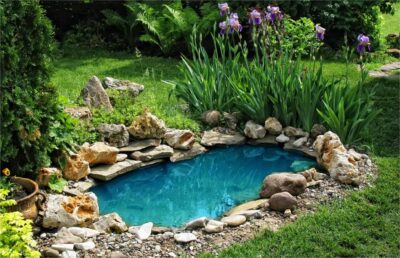Plants for a natural swimming pool
If you love swimming and want to own one in your home, you can’t go wrong with a natural swimming pool. Not only will you get a swimming pool, but one built into the environment. Natural swimming pools are free of chemicals or any artificial additives, a true purist’s dream. As there are no chemicals in natural swimming pools, cleaning and other process have to be natural. Plants are nature’s answer to everything and whether it’s cleaning or beautifying your natural swimming pool, plants are the answer.
Best plants for your natural swimming pool
There are many plants you can add to your natural swimming pool, each with its benefits. To help make your decision easier, here are some of the best plants you can plant in and around your natural swimming pool.
Water lilies
Usually, when I hear lilies, all I think about are beautiful flowers. However, when it comes to natural pools, water lilies play a key role in maintaining the water temperature. Thanks to their length, water lilies tower over the pool, casting shadows and keeping the sun out of the water directly. This incidentally helps lower the population of algae in the pool.
Aquatic iris
You will love the aquatic iris, as long as you don’t plant it inside the pool. Aquatic iris’ will help beautify the surrounding of your natural swimming pool. In addition to this, they are known to help ensure the soil where they are planted is stable. This will help to prevent soil erosion in the surrounding barriers, keeping your natural pool intact.
Water primrose
Water primrose serves the main function of feeding animals and organisms in a natural swimming pool. Ducks and waterfowl are known to consume water primrose. After their death, water primrose still serves as food, this time to the microorganisms that reside under the surface of the water.
Azaleas
Azaleas serve in a decorative capacity and are best planted around the natural swimming pool. Thanks to the fact that they are easy to care for and evergreen, you will have your pool looking radiant all year long. It is worth noting, however, that azaleas don’t like too much water, so you should plant them as far back as necessary.
Maples
It doesn’t usually matter the amount of water present in the soil, a maple tree can grow either way. Maples are known to repel insects, so this will help make your natural swimming pool a pest-free zone. As an added benefit, the fruit of a maple tree can be harvested for other benefits. You should however plant the maple far from the pool to reduce the chance of shedding into the pool.
Water hyacinth
Nature’s purifiers, the water hyacinths are used to make water pure. The plant is known to absorb any impurities present in the water, and can also trap solid particles, preventing them from floating in the water. This will help ensure your natural swimming pool doesn’t become overrun with dirt and particles from other trees.
Aquatic canna
Canna lilies as they are more frequently known, help to remove excessive contents of elements like carbon and phosphorus. Without this, the natural swimming pool will cease to be viable for certain kinds of life. This will end up making it unsafe for use as well.
There are several other plants you can consider for your natural swimming pool. Pondweed, Duckweed, Cattails, Pickerel Weed, Arrowhead, Sedge Rush, Hornwort, Creeping Jenny, Golden Sword, Botswana Wonder, Frogbit, and, Water Lettuce are some great choices. You should consult your installer to more about how each plant will affect the life of your natural swimming pool.
You should also note that each plant may have added side effects that you may not find desirable. An example is an aquatic canna, which attracts pollinators to the swimming pool. There are other measures you can take to ensure you only get the benefits and keep out the unnecessary effects.
Why should you choose a natural swimming pool?
If you’re wondering why you shouldn’t just get a regular swimming pool, and prevent any plant research, you’re not alone. However, natural swimming pools have been proven to be better than artificial pools. Some benefits of natural swimming pools include:
It is cheaper in the long run
One plant after the next may seem to be too expensive, but when these are long-term solutions, they are a welcome purchase. The plants you site in and around a natural swimming pool are to help maintain the water quality. This is a continuous process, one that doesn’t require much effort or money to maintain. Unlike artificial swimming pools where chemicals and experts will need to be brought in, a natural swimming pool requires less.
Environmentally friendly
With a natural swimming pool, you won’t have to worry about terms like carbon footprint or chemical waste. A natural swimming pool is what we can refer to as an environmentalist’s dream. All the materials are organic and there is no need for any artificial additions whatsoever. You even get the added benefit of creating more trees and plants which in turn help improve the oxygen content of the atmosphere.
Are there any downsides to natural swimming pools?
There are downsides to almost everything and natural swimming pools are no exception. The good news however is that some of these downsides may not be a bother to you at all. The downsides of a natural swimming pool include:
Requires space
If you have the space to spare then you won’t have a problem with this. With all the plants that you will probably need to keep your pool healthy, there will need to be space for all of it. Where such space is not available, then a natural swimming pool may not be a valid option.
A wildlife garden
Some of the plants you put in and around your natural swimming pool may be ideal habitats for animals and microorganisms. The more you plant, the more life will be present, and the larger the ecosystem. Without the proper balance, you risk letting it get out of hand and even attracting predators. A proper plan and planting pattern will avoid this, however, so it is easily avoidable.










